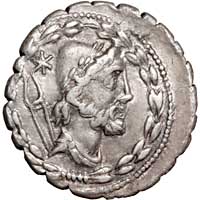| Home Page | Site Map | Useful Links | Email Me | Glossary | Next Page |
| ---------- The Sign Language of Roman Coins ---------- |
| Vulcan — God of Fire and the Forge |
| You can click on any coin image to see the full coin. |
Vulcanus, or Vulcan as we call him, was the Roman god of fire; both the constructive fire of the smithy, and the destructive fire of volcanoes, a word that is formed from his name. He was the son of Jupiter and Juno, and was supposed to have a smithy under Mount Etna, on Sicily, which erupted because of his anger whenever his wife Venus was unfaithful. His was one of the official cults of Rome, and there was a flamen (a senior priest) dedicated to him.
He was a very early Roman deity and it is likely that he derived directly from the Greek Hephaistos. There was a sanctuary in Rome's forum, the Volcanal, which was rumoured to date back to the 8th century BCE. Even if this was only a rumour, excavations in the Roman forum have uncovered a votive deposit from this sanctuary, dating from the mid 6th century BCE, which contained an Athenian black-figure vase with an image of Hephaestos.
His festival, the Vulcanalia, was on August 21st. Coincidentally, according to Cassius Dio, on that date in 217 CE, much of the Flavian amphitheatre was destroyed by a fire started by lightning!
Very few Roman coins show Vulcan. Of these, I have only three. Some are Republican denarii, like that above right; a serrate denarius of L. Aurelius Cotta from 105 BCE. This shows a bust of Vulcan in his typical conical cap, his tongs behind his head. The cap would have been sheep leather, with the wool turned inside; this would provide protection from the sparks of his forge, and perhaps some insulation from the heat.
I am also able to show two rather nice Imperial examples. First, the antoninianus of Valerian on the left. This was one of small group of coins from 259-260 CE, issued in the names of the emperor Valerian, his son and co-ruler Gallienus, and Gallienus' wife Salonina.
All three showed deities in their temples. Gallienus had Mars, the god of war; Salonina had Segetia, a minor agricultural goddess; and here is Vulcan for Valerian, holding his pincers and hammer, with his forge to the left.
The legend is simply DEO VOLKANO — (A Coin Of) The God Vulcan.
The nature of the strike of this coin has left out any details of Vulcan's clothing, but you can see that much better on the antoninianus of Claudius II on the right, from 268-270 CE. Here you can see once again his conical hat, and also his typical Greek exomis, a short chiton with one shoulder bare.
Again, he is holding his tongs and hammer. The legend on this coin is REGI ARTIS, (dedicated to) the King of the Arts, the arts in question being those of metalworking and fabrication.
Two of the last three coins on this page are not Roman, but Greek. The first is a much earlier specimen from around 300 BCE. It does not show Vulcan, but is of interest because it shows a related deity, a Kabeiros.
The Kabeiroi (or sometimes Cabiri) were involved in the secretive mystery rites of the islands of Lemnos and Samothrace, and very little is known about them, but in Greek myth they were children or grandchildren of Hephaistos.
Although his hat looks similar to Vulcan's, it is described as a pilos, a simple conical hat like those worn by the heavenly twins, the Dioskouroi.
The second coin is from the first century CE and shows a Kabeiros holding a large hammer and an animal rhyton, an ornate sort of drinking horn. Presumably this is the product of the Kabeiros' forge, though it certainly would not have been made with that huge hammer!
The final coin is from Thessalonika in the reign of Maximinus I Thrax, 235-238 CE. It shows the same type of Kabeiros as before, and this time there is an anvil behind him with an elephant tusk; the materials of his art.
| The content of this page was last updated on 4 January 2012. |
| Home Page | Site Map | Useful Links | Email Me | Glossary | Next Page |





